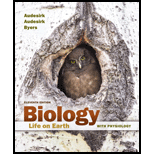
Concept explainers
Discuss some of the problems that would result. If the human heart were made of skeletal muscle instead of cardiac muscle.
To discuss:
The problems that would result if the human heart were made of skeletal muscle instead of cardiac muscle.
Introduction:
Heart is a muscular organ which helps in transportation of oxygen and nutrients through the blood into different parts of the body. It is also involved in removing carbon dioxide and other metabolic waste from the body.
Explanation of Solution
Skeletal muscle is striated, unbranched, voluntary muscle, which is under the control of the somatic nervous system. Cardiac muscle is found in the heart. It is also striated due to the presence of regular arrangement of sarcomeres. It is branched and involuntary muscle, which is under the control of the autonomous nervous system. Cardiac muscle is found only in the heart as it is a specialized type of muscle tissue. Its key role is to pump blood in different parts of the body. It helps in transportation of oxygen and nutrients through blood.
Skeletal muscle is voluntary in nature as one can cause their movement it according to their own wish, whereas cardiac muscle is involuntary (their movement is not under our control) and it is active all the time.
If the heart was made up of skeletal muscle, then after performing a constant workout, the mortality rate would have increased and this would have led to the condition of muscle fatigue and stopped heart from functioning. In cardiac muscle, muscle fatigue condition does not arise as it contains numerous mitochondria as compared to skeletal muscle. Presence of mitochondria results in the continuous supply of energy to the heart. Muscle fatigue leads to cause oxygen depletion in the body. Cardiac muscle provides non-stop supply of oxygen and nutrients into different parts of the body.
Skeletal muscle can easily get tired due to depletion of oxygen, whereas due to the presence of a large number of mitochondria in cardiac muscles, it is involved in the continuous supply of oxygen and nutrients to different parts of the body.
Want to see more full solutions like this?
Chapter 41 Solutions
Biology: Life on Earth with Physiology (11th Edition)
Additional Science Textbook Solutions
HUMAN ANATOMY
Fundamentals Of Thermodynamics
Genetics: From Genes to Genomes
Campbell Essential Biology (7th Edition)
Microbiology Fundamentals: A Clinical Approach
- Participants will be asked to create a meme regarding a topic relevant to the department of Geography, Geomatics, and Environmental Studies. Prompt: Using an online art style of your choice, please make a meme related to the study of Geography, Environment, or Geomatics.arrow_forwardPlekhg5 functions in bottle cell formation, and Shroom3 functions in neural plate closure, yet the phenotype of injecting mRNA of each into the animal pole of a fertilized egg is very similar. What is the phenotype, and why is the phenotype so similar? Is the phenotype going to be that there is a disruption of the formation of the neural tube for both of these because bottle cell formation is necessary for the neural plate to fold in forming the neural tube and Shroom3 is further needed to close the neural plate? So since both Plekhg5 and Shroom3 are used in forming the neural tube, injecting the mRNA will just lead to neural tube deformity?arrow_forwardWhat are some medical issues or health trends that may have a direct link to the idea of keeping fat out of diets?arrow_forward
- Can I please get this answered with the colors and how the R group is suppose to be set up. Thanksarrow_forwardfa How many different gametes, f₂ phenotypes and f₂ genotypes can potentially be produced from individuals of the following genotypes? 1) AaBb i) AaBB 11) AABSC- AA Bb Cc Dd EE Cal bsm nortubaarrow_forwardC MasteringHealth MasteringNu × session.healthandnutrition-mastering.pearson.com/myct/itemView?assignment ProblemID=17396416&attemptNo=1&offset=prevarrow_forward10. Your instructor will give you 2 amino acids during the activity session (video 2-7. A. First color all the polar and non-polar covalent bonds in the R groups of your 2 amino acids using the same colors as in #7. Do not color the bonds in the backbone of each amino acid. B. Next, color where all the hydrogen bonds, hydrophobic interactions and ionic bonds could occur in the R group of each amino acid. Use the same colors as in #7. Do not color the bonds in the backbone of each amino acid. C. Position the two amino acids on the page below in an orientation where the two R groups could bond together. Once you are satisfied, staple or tape the amino acids in place and label the bond that you formed between the two R groups. - Polar covalent Bond - Red - Non polar Covalent boND- yellow - Ionic BonD - PINK Hydrogen Bonn - Purple Hydrophobic interaction-green O=C-N H I. H HO H =O CH2 C-C-N HICK H HO H CH2 OH H₂N C = Oarrow_forwardFind the dental formula and enter it in the following format: I3/3 C1/1 P4/4 M2/3 = 42 (this is not the correct number, just the correct format) Please be aware: the upper jaw is intact (all teeth are present). The bottom jaw/mandible is not intact. The front teeth should include 6 total rectangular teeth (3 on each side) and 2 total large triangular teeth (1 on each side).arrow_forward12. Calculate the area of a circle which has a radius of 1200 μm. Give your answer in mm² in scientific notation with the correct number of significant figures.arrow_forwardarrow_back_iosSEE MORE QUESTIONSarrow_forward_ios
 Human Physiology: From Cells to Systems (MindTap ...BiologyISBN:9781285866932Author:Lauralee SherwoodPublisher:Cengage Learning
Human Physiology: From Cells to Systems (MindTap ...BiologyISBN:9781285866932Author:Lauralee SherwoodPublisher:Cengage Learning Human Biology (MindTap Course List)BiologyISBN:9781305112100Author:Cecie Starr, Beverly McMillanPublisher:Cengage Learning
Human Biology (MindTap Course List)BiologyISBN:9781305112100Author:Cecie Starr, Beverly McMillanPublisher:Cengage Learning Biology (MindTap Course List)BiologyISBN:9781337392938Author:Eldra Solomon, Charles Martin, Diana W. Martin, Linda R. BergPublisher:Cengage Learning
Biology (MindTap Course List)BiologyISBN:9781337392938Author:Eldra Solomon, Charles Martin, Diana W. Martin, Linda R. BergPublisher:Cengage Learning





